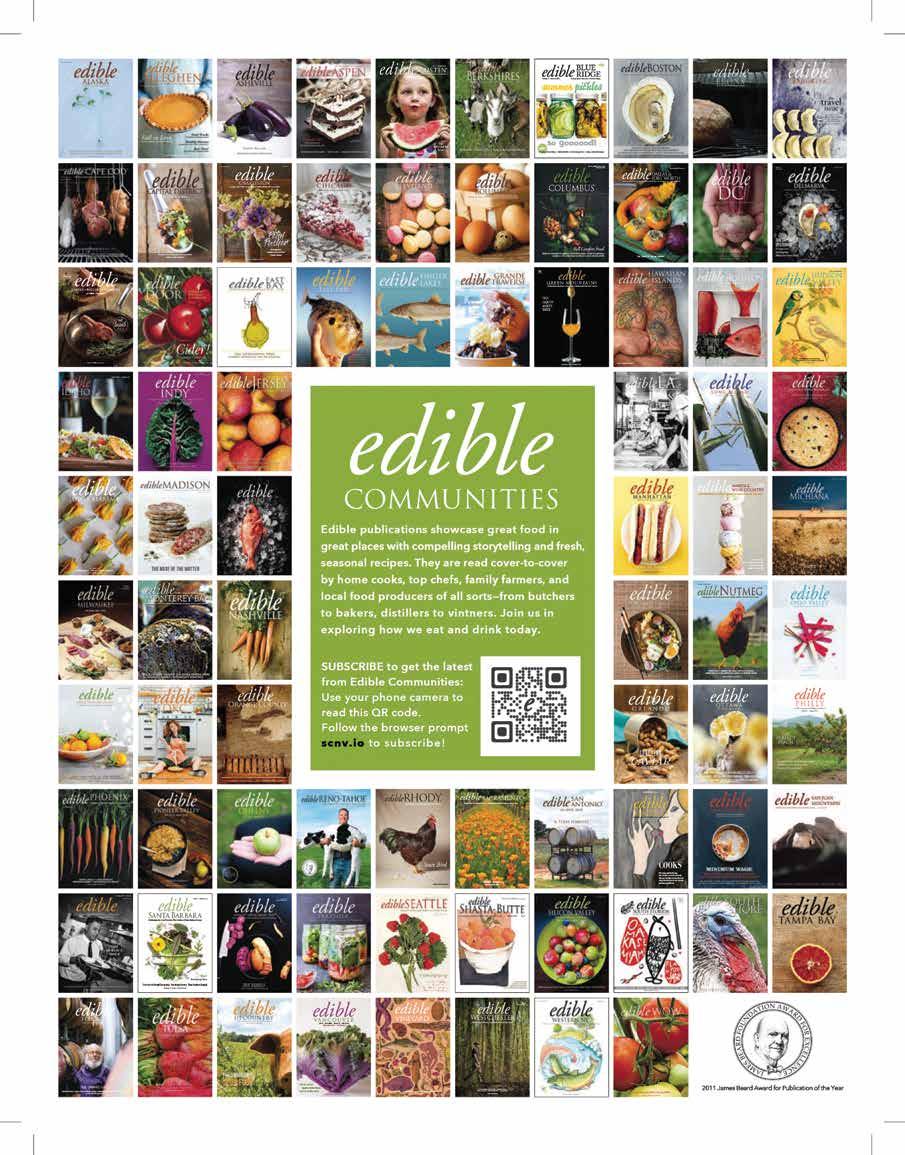GETTING SCRAPPY







That’s an old saying with new relevance since onethird of the food produced in the US goes to waste while 41 million Americans experience food insecurity and farmers struggle to get their produce to market. Cer tainly we can do better, right?


Before the idea of food waste makes your eyes glaze over, hang with us for a minute. Edible San Diego is step ping into the fray, diving deeper into food and wellness topics in San Diego County than ever before. We present you with multiple ways to explore, engage, and enjoy— here in our magazine, in daily stories online, and on our bustling social media platforms.

Want to do better? Find a detail you can relate to and start there. We’ve gathered tips to take you from start to finish with the life cycle of food and to show you how we all fit into the picture. The first step is awareness—so welcome!


We hope this spring issue of Edible San Diego inspires everyone to pause for a moment and open up to some new habits of growing, shopping, storing, preparing, enjoying, and sharing food.

Let’s get scrappy and take steps that mindfully build and celebrate the plenty that surrounds us. What a deli cious vision!
Katie Stokes Publisher, Edible San Diego








Here’s a short list of produce that can be grown from scraps accompanied by incomplete how-tos that require a little more research—but seriously, did you know that you can grow more ginger from a piece of ginger? Or that mushroom stems can grow new mushrooms? And that romaine lettuce sprouts from the end piece we normally cut off and toss in the trash? Well, now you do.
If you happen to have an extra piece of ginger with lots of knobs (storebought works fine), you have a good contender to grow your own. The edible part of the ginger is not the root but a rhizome, or subterranean plant stem. Soak the ginger in water overnight and plant in good soil, either potted or straight in the ground, the next day. One thing to keep in mind for growing in our waterwise climate is that ginger likes moisture-rich soil. The best planting time is late winter or early spring, so get to it and be ready to harvest in eight to 10 months.
Remove the mushroom caps and reserve them for eating. Cut stems to quarter-inch pieces and plant in a container as simple as a cardboard box by layering with a suitable growing medium like grain, straw, or sawdust (this is also a good way to use up your spent coffee grounds). Your box will need to be covered, but make sure there are holes for airflow and keep moist with daily misting. You’ll have a crop of mushrooms to harvest in five to six weeks.
Place the leftover bottom of a romaine lettuce stalk in a shallow bowl with half an inch of water, taking care not to cover the top. Keep in a brightly sunlit area and refresh the water daily. You can transfer the plant to soil once new lettuce sprouts about one to two inches long.
Three craveworthy dishes where you’d least expect them
BY FELICIA CAMPBELL AND OLIVIA HAYOSometimes the best meals are the ones we unexpectedly stumble upon, whose flavors and textures transport us beyond the ambiance of the restaurant itself. A few of our favorite dishes are so good in their own right that they’ve ended up on our permanent rotation.
Nam Khao Tod (Crispy Rice Salad) SUPANNEE HOUSE OF THAI, POINT LOMACrisp-fried puffed rice is tossed with loads of fresh cilantro, kaffir lime leaves, lemongrass, and slivers of ginger, punctuated by salty roasted peanuts, sweet red onion, housemade sour pork sausage, and a hit of hot chile. This traditionally Lao and northern Thai dish isn’t easy to find in restaurants, but Supannee House of Thai makes a particularly addictive rendition. 2907 Shelter Island Dr. #110, Point Loma, San Diego • sdthai.com
LAS CUATRO MILPAS, BARRIO LOGAN
This barrio institution has been around since 1933 and is open for breakfast and lunch. There’s a line around the block by 11am on most days at the cash-only establishment, so the pro move is to go for a breakfast of hand-rolled tortillas, hot sauce, taquitos, crispy tacos, and our musthave bowl of tamale, rice, and beans. You’ll find your tamale practically submerged in a stew-like symphony of toothsome pinto beans and red rice. Be sure to add a scattering of cilantro, raw onion, and lime. 1857 Logan Ave., Barrio Logan, San Diego • las-cuatro-milpas.com

You may head here for groceries, but stay a little longer for this dish of beef braised in an herbaceous broth of parsley, cilantro, chives, and fenugreek. Infused with aromatic Persian lime, the turmerictinged stew is satisfyingly spooned over basmati rice alongside blistered tomato, flatbread, and a chopped herb and cucumber salad. Portions are generous, so share or look forward to leftovers.
12342 Poway Rd., Poway, San Diego • northparkproducepoway.com


 BY MIKE SHESS, SAN DIEGO BEVERAGE TIMES
BY MIKE SHESS, SAN DIEGO BEVERAGE TIMES







Not just a beer town, San Diego overflows with a variety of local, quality beverage producers. Here are some highlights of what’s happening around the county.




Considered a peer to beer in Europe, Americans are only now starting to understand that cider is a righteous and available alternative. Established in 2016, Newtopia Cyder has a sophisticated operation that produces the fer mented apple drink in small batches. Newtopia is taking the knowledge from its roots in the beer industry to create something distinct and awesome with two tasting rooms in San Marcos and Scripps Ranch. Their diverse lineup of flavors range from dry to sweet, proving why Newtopia is helping lead the burgeoning cider community of San Diego. » drinknewtopia.com

The only sake brewery in San Diego—and one of the few in Southern California—Setting Sun Sake Brewing Co. is located in the exciting Miralani Makers’ District in Miramar (an industrial park that’s home to a coffee roaster, mead maker, breweries, and more). They recently expanded to the adjacent suite to open a new tasting room after two years in the business. We’re fans of the cloudy sake, but be sure to try any of the specialty sakes that are on tap that day. Setting Sun frequently collaborates with their neighbors and holds fun events like sake and cheese pairings. » settingsunsake.com
Nestled on the south side of the mountain, Palomar Artesian Springs is a worthwhile stop for water buffs. The spring is owned and operated by the Palomar Mountain Spring Water Company and is free and open to the public. Located on South Grade Road, the spring’s fill station is very easy to miss; take it slow and watch out for motorcyclists zooming around the nearby turn! When San Diego Beverage Times visited, one tap was open for filling large bottles and there was also a water fountain. For those that aren't into the drive, Palomar Mountain Spring Water can be found bottled throughout San Diego County and is available for delivery. » palomarspringwater.com
Keith A. Lord is a global chef with a creative and conscientious approach to food. As culinary director at the Wild Thyme Company, he strives to reduce waste by rescuing imperfect produce from local farmers, regrowing watercress in coolers behind the catering kitchen, and turning kitchen “trash” into treasure.
Lord says he’s motivated by an abiding respect for food—and sees waste as a personal challenge. He credits his principled approach to cooking in two formative kitchens: one in Hawaii, where the major ity of ingredients came out of the water, and another in San Francis co, where the fridge was packed to the brim with local produce each week. His mission was to use every last morsel so the kitchen could start over again with fresh ingredients the following Monday.
In the catering world, waste is a reality, but Wild Thyme has implemented simple and inventive practices that make a positive impact. Lord says one of the easiest methods to reduce waste is to consider the potential of kitchen scraps that would otherwise be bound for the bin. In the Wild Thyme kitchen, strawberry tops are incorporated into tapenade, carrot greens are transformed into pesto, and charred onion scraps become a sweet and decorative ash to top shots of Mexican street corn.
Some of the catering company’s most eye-catching dishes have been inspired almost entirely by cast-offs, like Tuscan Five-Spice Grouper with seasoning crafted from bruised mint, citrus peels, and vanilla pods and a root vegetable peel salad. “It’s a beautiful

dish, and most of the flavor comes from scraps,” says Lord.
But Wild Thyme’s most dynamic presentation of waste reduc tion might be their painted tablescapes—lively food installa tions highlighting deconstructed takes on savory and sweet dishes ranging from cassoulet to peach cobbler. The experience unfolds like a flash mob performance, where elements of the dish are strewn and swirled across the table covered in recycled paper. Guests scoop up bites with edible implements like toast or doughnuts. There’s no cutlery or plates involved, and practi cally no waste.
With time and creativity, it’s possible for every chef and home cook to reduce waste and use ingredients to their full potential.

Lord uses spent grains from Malahat Spirits Co. to bake breads, and maintains similarly beneficial relationships with Catalina Offshore Products, Tim Connelly and Moceri Produce, Culver Beer Co., Wrench and Rodent Seabasstropub, the Green Cowboy, and Cyclops Farm.
SERVES 4
SHAVED VEGETABLE SALAD
6 cups shaved crunchy raw vegetables (such as asparagus, fennel, carrot, red and/or black radishes, golden and/or Chioggia beets)
½ cup mint leaves, torn if large 1 lemon
2 tablespoons extra-virgin olive oil
½ tablespoon sugar
Kosher salt and cracked black pepper to taste
Note: You can skip the lemon, olive oil, and sugar and try it with the Avocado Ranch Dressing on page 8.
4 (5-ounce) pink or brown hook-andline grouper fillets
Kosher salt and cracked black pepper to taste
1 teaspoon sugar, divided
2 tablespoons extra-virgin olive oil Pinch Tuscan Five Spice*
*recipe follows
Make the salad by placing shaved veg etables and mint in a large bowl; finely grate lemon zest over vegetables, cut lemons in half, and squeeze juice into bowl. Drizzle with oil and season with sugar, salt, and pepper. Toss to coat.
Note: Vegetables can be shaved 6 hours ahead. Submerge in a bowl of ice water and chill. Drain and pat dry before using.
Prepare the grouper with a dry rub of salt and pepper and sprinkle the finish side of each piece with ¼ teaspoon sugar.
Heat olive oil in a nonstick pan over high heat. Add the fish and cook until golden brown on the outside and just cooked through the center, about 4 minutes each side.
Serve the fillet on top of the shaved vegetable salad with a little sprinkle of Tuscan Five Spice.
Look for new seasonal recipes every week and get inspired at ediblesandiego.com.
These nutrition-packed greens are way more than a Southern side dish.
Celebrate spring with bright flavors and ingredients that mark the season.

This stew is Mexican comfort food at its finest—and happens to make an amazing lunch.
Savory rice porridge is a delicious way to stay healthy year-round.
This is a very loose recipe using the peels and/or slices from oranges that have gone past their prime, bruised mint leaves, the browned outer leaves of fennel, lime peels, and vanilla bean pods (optional) after all the tiny vanilla seeds have been removed.
Dry each ingredient individu ally (as drying times will vary) on a silpat or parchment paper in a 200° oven until dry and crisp, mix ing together occasionally. Cool for 30 minutes.
Add dried ingredients to spice grinder and grind until powdery consistency; pass through a finemesh sieve to remove any large pieces.

Store in an airtight container for up to 2 weeks.
MAKES ¾ CUP
2 large bruised, overripe avocados, halved, seeded, and skinned
¼ cup liquid from feta cheese
½ teaspoon lemon juice
¼ teaspoon granulated garlic
¼ teaspoon dried parsley
¼ teaspoon dried dill
¼ teaspoon dried chives
Pinch kosher salt
Cracked black pepper to taste
In a food processor or high-speed blender, combine avocado, feta liquid, lemon juice, garlic, parsley, dill, chives, and salt; pulse in short spurts until combined. Season to taste with black pepper. Adjust consistency by adding more avocado to thicken the dressing or more feta liquid to thin it.
Look for more scrappy recipes from Keith Lord this spring on ediblesandiego.com.
Lord’s recipes are flexible with simple substitutions, like using buttermilk or water in place of feta cheese water in the Avocado Ranch Dressing recipe or omitting the spent vanilla pod and making a Tuscan four spice instead.





There are many benefits of raised bed gardening, one of which is the ability to plant far more densely than in-ground gardening. With raised beds, there’s no need to plant in rows, except for vining beans and peas and only because they need a single-plane vertical support.

Over the years I’ve developed a simple system for spacing summer vegetable plants in raised beds. It’s a secret system, but I’m sharing it with you.
I start with cylinders formed from three zip ties (each about six inches long) plus one sheet of concrete reinforcing mesh measuring three and a half feet tall by seven feet wide, with openings approxi mately six inches across.
To make the cylinders, I first lay each sheet on the ground, then pull the short ends together. I lace zip ties through the mesh to hold the ends of the sheets together—one at the top, one at the bottom, and one in the middle. When I turn the cylinder upright, it forms a freestanding cage.
The cylinders then determine how I space plants in raised beds. For example, each cylinder supports:
° Two tomato plants, planted inside the cylinder
° Six cucumber plants, three spaced evenly around the inside of the cylinder, three spaced evenly around the outside (arrange so the inside and outside plants are staggered)
° Three melon plants spaced evenly around the outside of the cylinder I plant eggplants, basil, cilantro, pep pers, and so on, in the spaces between the cylinders.
While spacing is important, so is hav ing at least two raised beds to work with, especially if you grow edibles in the
nightshade family (tomatoes, eggplants, peppers, tomatillos, potatoes). Plant all those plants (except potatoes, which do better in a half whiskey barrel) into the same bed. The next year, move them all to the second bed. The third year, they go back in the first bed (or if you have many beds, move them to any bed where no nightshades grew the year before).
This kind of rotation is key to success, and here’s why: Nightshade plants are especially susceptible to root-knot nema tode, leaf viruses, fungi, and all sorts of other pathogens that are deadly to the plants. When the pathogens’ favorite food is in the ground, the pathogen populations explode. The next year, the pathogens are still hanging around in high numbers, ready to go to town on the new seedlings. Rather than plant nightshades there, go with edibles that the pathogens don’t seem to bother: melons, squash, cucumbers, beans, peas, basil, etc. Without their favorite food, the pathogen populations crash. So, by
year three, it’s safe to plant nightshade plants there again.
People often say to me, “I used to grow great tomatoes, but in the last few years, my tomato plants have done terribly and I’ve gotten no tomatoes.” I always ask if they plant tomatoes in the same location every year. Inevitably they confess, and that’s exactly the problem.
Garden expert, designer, and author Nan Sterman specializes in low water, sustain able, and edible landscapes. She is the host of A Growing Passion, a TV show that ex plores how plants power the planet. Episodes air on KPBS television on Thursday nights at 8:30 and Saturday afternoons at 3:30, and on Monday nights at 8:30 on KPBS2. See past episodes online at agrowingpassion. com. Sterman’s latest book is the just-re leased Hot Color, Dry Garden available in bookstores, online, and on her website www. waterwisegardener.com. She runs the popu lar Facebook group San Diego Gardener and leads international garden tours.









ed·i·ble adjective fit to be eaten
If we gathered global food waste into one pile, we’d have a sad and savage mountain weighing over 1.3 billion tons a year. The Food and Agriculture Organization of the United Nations esti mates that if this pile of rubbish were a country, it would be third behind China and the US in greenhouse gas emissions (GHG). All that isn’t even accounting for the other avenues of waste like packaging and additional GHGs coming out of production and distribution from commercial, industrial, and institutional sec tors of our densely complex global food system—or the 25% of the world’s freshwater supply that is spent growing wasted food.
According to the National Resources Defense Council (NRDC), in America, the cost of consumer food waste is estimated at $218 billion annually, and an average of 68% of all food discarded as tracked in kitchen diaries was potentially edible. The NRDC divides the term edible into two categories: typically edible and questionably edible. Their examples identify “pizza, liquid coffee, and bananas without the peel” as typically edible. I think I’ve found my new eating identity under the questionably edible items because I’m a “potato peels, beet greens, and carrot peel and tops” kind of gal.
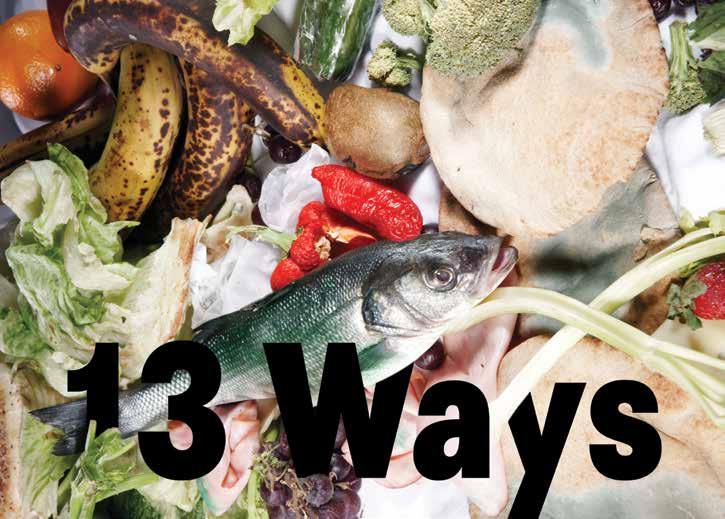
Moving on to considering how such global and national numbers relate to us on a county level, let’s try to comprehend how much of this wasted food is grown in our soils. The county’s size is nothing to scoff at: second in the state in terms of population, fifth in the country. According to the San Diego Farm Bureau, with only 5,000 farmers, we are the 19th-largest farm economy among over 3,000 counties and worth $2.88 billion annually to the region; the largest producer of avocados in the nation; fifth in lemons; ninth in strawberries; and 10th in egg-laying hens. As the San Diego Food System Alliance’s (SDFSA) Save the Food public educational campaign reveals, trashing one egg wastes 55 gallons of water.
With a regional population of nearly 3.1 million and the county Tourism Au thority reporting a record 35 million visitors to the region in 2017, there are many mouths to feed. San Diego’s culinary scene and unique regional proximity to Ti juana is attracting a bigger spotlight from national media that will no doubt attract a bevy of tourists in the years to come. And where there are a lot of people eating, there will be a lot of food wasting.
Most of us are more or less limited in our ability to address the systemic food waste crisis in every way but two—managing your personal waste footprint and being a part of the collective action. Just taking steps to curb your food waste makes you part of the collective action, but if you seek to play a bigger role in the community, look to orga nizations. SDFSA, Feeding San Diego, and the San Diego Food Bank, as well as San Diego County and local government agen cies are working to vastly improve public outreach and food recovery efforts, narrow the gaps on food insecurity, and update policy on waste management practices.
So tell your friends, roll your sleeves up, and get ready to jump into this fight against waste with us. We’re here to eat it all. You’ll enjoy saving money and feeling healthier— because when you do what’s better for the planet, you’re doing what’s best for yourself and everyone you care about.
Consider meal planning an act of caring for your future self. I’m not sure what your future self wants, but mine wants to be well fed. One of the best ways to start is to create a list of all the foods by ingredient and dishes that you and frequent din ing companions enjoy and need most. It doesn’t hurt to also note any food aversions or allergies. Add on favorite restaurants or spots you want to try and you’ll have a quick guide to plot dinner at home or out that you know everyone will like. Coordi nate recipes by similar themes to minimize excessive buying and build leftovers into the meal plan. For example, in my house this week we’re planning to have chicken tacos for dinner on Tuesday and chicken taco-joes (leftover shredded taco chicken in a bun) for dinner on Thursday. It’s not fancy but it’s family-friendly and delicious. We also like to dedicate one meal a week to eating leftovers or pantry meal challenges.
I’m not trying to turn you into a type-A robot, but beverage planning is something to try. The importance for hydration drives a biological need worth over $250 billion a year to soft drink manufacturers that is expected to grow to nearly $390 billion by 2025. Soft drinks are consumed at an average rate of one can a day per American in our country.
At home, rely heavily on water, coffee, tea, and kombucha by the growler in order to reduce beverage packaging consump tion. A small box in your car trunk is a good place to store travel coffee mugs and canteens for when you forget them at home. I also try my best to bring my own filtered tap water in a reusable canteen so I’m not paying for filtered tap water in a plastic bottle. Encounters with disposable beverage containers are bound to happen on social occasions, but do your best to be conscious of it.
Locals have the good fortune of the world’s best selection of craft brewers (over
150 operational brewhouses!) that are happy to top off refillable growlers for a reasonable fee. An added pro tip for bakers is to ask your favorite brewer for spent grains to bring home for baking richly flavored breads. We like West Coaster’s online and frequently updated brewery list that ranks them all alphabetically.
To that effect, plan all your household purchases if you can. Let’s consider it good home economics. We return home from shopping with bags (reusable totes of course) of everything we purchase— groceries, beverages, household goods, cosmetics, and clothing—that often ends up going through the kitchen like a port of entry and exit from the home. Typically, no other room in a home compares to the kitchen in terms of waste generation. You can further reduce waste by using more hand towels and sponges instead of paper towels, and by purchasing cleaning and grooming products from a local refillery like the Sonora Refillery in Oceanside and Earthwell Refill in Kensington.
Keep things simple with single ingre dients, like a snack of carrot sticks—and not the baby carrots that are washed in chlorinated water and come in a plastic bag. Buy as much loose produce as pos sible and avoid packaging.
Meals can be as straightforward as a nice piece of yellowtail with rice and steamed broccoli, which might sound boring to some, but a little of the right seasonings and a few fresh herbs means a delicious healthy meal is on the table in under five ingredients.
In 2018, the Proceedings of the National Academy of Sciences (PNAS) released a first-of-its-kind report accounting for the biomass distribution on Earth, revealing that human and livestock biomasses far surpass that of all wild animals combined, and domesticated poultry biomass was





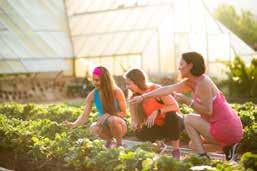


three times higher than that of wild birds.
Start thinking of how veggies can play center stage in more of your meals and give animal proteins a smaller sideshow portion—or skip altogether.
Too much food on a plate often ends up in the trash. If you do end up with more than you can chew through, see numbers six and seven.
This applies to both whole foods fresh from the grocery store and leftovers. Repurpose glass food jars for affordable containers or invest in pieces with mini mal plastic. ReVessel is a local company that hopes to revolutionize your food storage solutions with stainless steel bases and bamboo leakproof lids. (Sign up at revessel.com for product launch notifications later this year.) Use labeling practices to identify and date leftovers and find comprehensive sea sonal guides on how to best store items at savethefood.com.
I’m a big fan of the leftover challenge. Chop things up, scramble them with eggs or fry them with rice, smother them in a tortilla with cheese and call it a quesadilla. Kitchen sink dishes like casseroles, the infamous hot dish from the Midwest, or shepherd’s and pot pies are all great for us ing up larger quantities of odds and ends.
Fruit and vegetable skins tend to have the highest concentration of nutrient benefits, and most of the time we peel them off and throw them away. Scraps aren’t often preferred socially, but they are well worth eating in items like salads, pestos, soups, omelets, and fritters. I like to make mashed sweet potatoes by
boiling them whole with the skins on just to save the skins, which peel off easily and fry up crispy with a few dashes of soy sauce in a pan with butter.
“Best by” and “sell by” dates are not regulated and are better recognized as general indicators for freshness or qual ity. Avoid eating older foods that have visual signs of mold; meats, oils, and nuts are fairly easy to identify as rancid with a sniff test.
Different ways to preserve foods include freezing, canning, pickling, fermenting, and dehydrating. Deborah Scott, chef-partner of the Cohn Restau rant group, shared a suggestion to freeze extra fresh herbs with olive oil in ice cube trays that can be tossed into a pan when you are getting ready to sauté.
Pesky plastic straws were last year’s hottrending trashy icon, swiftly inspiring a whirlwind of media and a statewide ban. If you recall, Proposition 67 from 2016, better known as the single-use plastic bag ban, required food retailers to make and charge customers for—get this—sturdier plastic bags. The legislation falls short in the need to drive consumer products away from the use of petroleum-based plastics altogether.
It also needs to be said that a paper straw after it’s been wet for more than three to five minutes is not worth the tree that died for it. In terms of reus able straw options, stainless is definitely a sustainable choice but both it and the plastic straw are likely to be here long af ter we’ve left this planet. If I were a titan of industry, I’d be making straws out of a far more industrial fiber like hemp.
Research suggests that though it’s often said that buying in bulk can save money, it actually leads to more food waste.
Composting isn’t for everyone, and I’d be willing to bet there are more people in the In-N-Out drive-thru on Sports Arena than there are tending to worm bins right now, but it’s worth giving it a try if you can. Yes, some say composting is easy, but anything that takes extra effort presents challenges, and this is one of those things that does require a bit of attention. Composting may not be practical for people living in multifamily housing, an unfortunate coincidence since these are the communities where food waste percentages tend to be highest. If composting isn’t your thing, look for a community Food2Soil compost hub to donate your compostable waste. If you are up for becoming a soil grower, check out their Smart Stack compost bin and more resources at inikasmallearth.org.


 BY JONI HARGRAVE
BY JONI HARGRAVE
“Keep Leucadia funky” is the per petual battle cry of the bohemian beach town where the real estate and retail are as eclectic as the people. Blink and you’ll miss the 2.5-mile coastal commu nity rooted in California surf culture, an undeniable quality that has attracted yogis, families, and foodies alike to the seaside stretch along San Diego’s North County.
Come as you are to this environmentally forward gem—hopefully that’ll be hungry, thirsty, active, and ready for anything.
From holistic spas and art walks to organic eateries, craft brews, and the freshest sus tainable seafood caught just miles offshore, there’s something for everyone.
So pack your weekender bag, grab your sunnies, and get ready to soak up clean, green boho beach vibes.
With rooms as breezy as the Leucadiabred brothers that run the place, and a location steps aways from the town’s best beaches and restaurants, life doesn’t get much better than calling this intimate, surf-inspired motel home. As for the extra perks, discount cards to local hot spots are included with each room along with beach cruisers ready to roll.
Or show up as early as 5am to score some glazed dough. Owned and operated by Tom and Emily Cheu for 29 years, this nostalgic establishment is as much a Leucadia institution as it is a doughnut shop. Unlike recent hipster joints, you
won’t find superfluous concoctions a la bacon or Cap’n Crunch—simply a classic lineup of all your traditional favorites.
Pop in for a quick pick-me-up at this small-batch specialty roaster serving hot joe along with an array of crafted teas. Try the Hammerhead, a shot of espresso poured over brewed coffee for an instant jolt of caffeine. And while you’re waiting, stroll through the adjoining Surfy Surfy for hand-shaped surfboards and Surfy-branded gear, then snap an Insta-worthy pic outside on the cafe’s famed Leucadia mural.
Seeing as Leucadia is the hub of all things wellness, align your chakras for the day with one of Gather’s beaming instructors. My vote is kundalini with Libby. It’s perfect for beginners, challeng ing for more advanced, and results in an
11:30AM
LUNCH AT NECTARINE GROVE
The perfect follow-up to a restorative yoga sesh is a nourishing meal at Nectarine Grove. Come hungry with any and all dietary requirements for this organic, grassfed, green-loving, kombucha-drinking, Paleo-friendly cafe that serves up outrageously good food for the mind, body, and gut flora. Owner Rhiana Glor transforms traditional menu items with nourishing ingredients that rival the originals. All items are 100% gluten-free using organic, locally sourced ingredients when possible.

Hits include the chimichurri steak bowl with butter nut squash noodles and the crispy chicken salad breaded in plantain chips and fried to perfection in avocado oil. Don’t miss droolworthy gluten-free goodies like fudgy vegan brownies and orange almond cake.
1PM
Venture into this throwback shop for new and vintage clothing, homewares, local art, surfboards, and eclectic odds and ends from California’s best eras. Created out of a frustration with big-brand domina tion, apparel industry professional turned shop owner David Patri decided to build his original collection that fits right in with fellow Leucadians. Note: In true nonconformist fashion, you never know when the place is going to be open, which I suppose just adds to the allure of this spot.
2PM
Rent any and all beach adventure equipment from e-bikes to stand-up paddle boards at The Hatch and walk the short switchback trail down the bluffs to this large stretch of sand located on Neptune Avenue between Jasper Street and Leucadia Boulevard.
If you haven’t felt Leucadia love yet, set your alarm for a stunning sunset on this 300-step path to one of North County’s most secluded beaches. Join couples, families, kids, and pets and watch as the sun paints a stunner of fluorescent hues before it finally melts into the horizon. (Check the internet to confirm golden hour.)
7:30PM
Featuring local artists, beers, and wine, this Thai-Lao eatery gets bustling fast and for good reason. With a lineup of organic bone broth-based phos, classic noodle dishes, curries, and unexpected starters like Laotian-style lemongrass sausage or banh xeo (a crispy turmeric rice crepe with ground pork and wild shrimp), choosing what to order may be the toughest decision you make all day.
Hopefully by now you’re wearing elastic, because a visit to North County is not complete without a taste of Mexican fare. The sticker-tatted pink taqueria situated on historic Highway 101 is home to the tastiest tacos in town. This fine establishment is always full (from 8am to 2am) of excited patrons in booths doublefisting Juanita’s red and green salsas and tearing away the neon yellow paper that holds the key to their heart’s desire—at least for that moment. Try a trio of street tacos, or if you’re with a friend, split the pollo asado burrito packed with chunks of stewed chicken, crunchy onion, and creamy guac.
and easily North County’s best break fast burrito, the cafe offers a Caribbeanish assortment of smoothies, acai bowls, and burritos paired with a friendly staff. Get the tropical burrito: With pepperflecked eggs, black beans, avocado, and grilled plantains glued together with melted jack cheese in a whole wheat tortilla, it’s perfect.






for the recipe—to which Karyn will kindly oblige.
8:30AM
BREAKFAST BURRITOS AT MOZY CAFE
Home of Leucadia’s low-key paradise
The way food should be: slow, sea sonal, simple, and absolutely delicious. Let chef and owner Karyn Kraus Smith nourish you with her organic provi sions and affable energy. Committed to providing seasonal and local fare to fuel her foodie community, the menu is on constant rotation. What you will find at every visit? A bone broth-based soup of sorts that will likely prompt a request
High fives to high vibes at Four Moons holistic day spa, the ultimate retreat for mind, body, soul, and retail Rx. Like walking into a tranquil Balinese sanctu ary, this vibrational escape will leave you feeling like, well, a unicorn. Don’t miss the Thrival CBD Massage, an unforget table full-body massage using potent tinc tures and cannabidiol superfood balm.
6PM
This sustainable seafood eatery owned by fisherman, diver, and restaurateur John Park is known for sourcing flavor ful fish from local hook-and-line fisher men. Start with a half dozen oysters and finish with the grilled fish bowl.




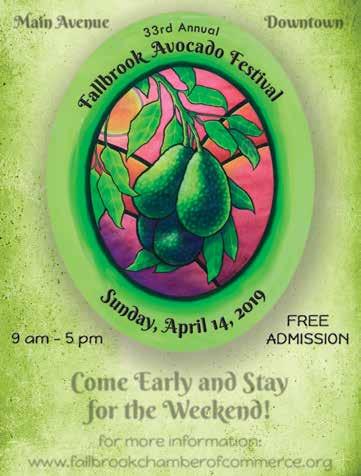

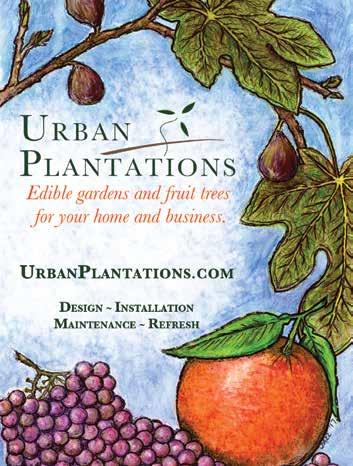


There’s especially lots to gawk at in and around the Anza-Borrego Desert State Park this time of year. That damp winter we had will bring forth good reasons to hike around the park’s 110 miles of foot trails in search of desert blooms from hundreds of flowering species of plants that speckle the scenery with sensational flair. The park is the largest in the state and second largest in the contiguous US, spanning from Riverside and Imperial counties through one-fifth of San Diego County.
Discover breathtaking colors and cacti shooting toward the sky while exploring the dramatic desert landscape at its peak season of beauty. Keep your eyes open to glimpse the legendary bighorn borrego, sheep native to the Colorado desert region.

Art enthusiasts can head to Borrego Springs within the park’s 600,000 acres for the 13th Annual Plein Air Invitational at the Borrego Art Institute March 3–31. On the way you’ll spot at least a few of the 130-plus full-sized Metal Sky Art Sculptures by artist Ricardo Breceda. Find maps and guides online to help navigate through dirt roads to view bigger sculptural attractions like saber-tooth tigers, dueling dinosaurs, and a 350-foot serpent.
Off-road enthusiasts will be hard-pressed to run out of room to drive on with over 500 miles of trails that take adventurers through canyons to vista points and obscure campsites primed for stargazing.
The Red Ocotillo does not disappoint for a scrumptious brunch on their dogfriendly patio next to the restaurant’s gated garden. » parks.ca.gov/anzaborrego
Spring in San Diego is a pretty joyous event if you’re a lover of artichokes, asparagus, and green garlic. Cherimoyas (a.k.a. custard apples) will be luscious in this peak part of their season, kiwis will keep on being fuzzy and sweet, and the citrus will be super juicy. Expect the first cucumbers of the year to start getting crunchy and chard leaves as big as your face in April. Rhubarb will be around just long enough to make some magic happen with strawberries. And really friends, there is no better time for peas. Find more seasonal treats and recipes to try at ediblesandiego.com.
Every Friday morning, head brewer Sam Olson brings her weekly spent grains to the baker at Fourpenny House, who turns them into freshly baked Scottish breads, scones, and shortbreads that you can buy warm from 3–7pm at the La Mesa Village Farmers’ Market. Isn’t that convenient?
» fourpennyhouse.com
The first ever Got Green? event at the San Di ego Botanic Garden will promote and share info on plant-based eating with live demonstrations, tips on planting, growing, and harvesting your own vegetables from 10am–4pm on Mar. 16.
» sdbgarden.org
Taking place on Mar. 16, the Sabor Latino! Food, Wine, and Beer Festival is a 21-andolder event expected to be a big attraction as part of the festivities for the 26th annual San Diego Latino Film Festival Mar. 14–24. Tickets will get you unlimited tastings of beer, tequila, and wine paired with Latin dishes from popular breweries,
distilleries, wineries, and chefs across the San Diego and Baja California region.

» sdlatinofilm.com
Enjoy baked goods from a dozen pastry chefs at the Chef-Driven Bake Sale, benefitting Monarch School at Herb & Eatery on Mar. 31 from 10:30am–1pm.
» friendlyfeast.org

The Second Saturday Farm Tour at Dickinson Farm in National City is on Apr. 13. Rain or shine, you can learn about what they are growing and raid their larder from 2–4pm.
» dickinson.farm
Celebrate “green gold” at the 33rd Fallbrook Avocado Festival on Apr. 14 with free admission from 9am–5pm.
» fallbrookchamberofcommerce.org

San Diego EarthWorks’ 30th Annual EarthFair will be held at Balboa Park on Apr. 28 from 10am–5pm. The largest free Earth Day fair in the world is a zero-waste event and has something entertaining for everyone with a parade, live music, children’s activity area, eARTh Gallery, Cleaner Car Concourse, and, most importantly, international food courts with vegetarian delights.
» earthdayweb.org
These restaurants are either locally owned, passionate about local sourcing, or both. Enjoy a delicious meal and make sure to tell our advertisers that Edible San Diego sent you!
A.R. VALENTIEN
11480 North Torrey Pines Rd., La Jolla 858-453-4420 • lodgetorreypines.com/ar-valentien
The Torrey Pines Lodge’s signature restaurant, A.R. Valentien, highlights regional San Diego cuisine served in an elegant, timbered indooroutdoor dining room overlooking the 18th hole of Torrey Pines Golf Course. Executive chef Jeff Jackson sources only the best local provisions, and the menu changes frequently based on seasonal fare available. The restaurant takes its name from a talented early-20th-century California artist whose works are exhibited throughout the restaurant.
MISSION BEACH
ESCOGELATO
122 South Kalmia St., Escondido 760-745-6500 • escogelato.com

Located in the heart of Escondido, EscoGelato is made fresh daily using the highest quality ingre dients and fresh fruit sourced from local farmers. The result is a luscious, super-creamy gelato that’s full of flavor. You will taste the difference. In ad dition to the main event, enjoy a nice selection of paninis, soups, salads, coffee, and tea.
JUICE WAVE
3733 Mission Blvd., Mission Beach 858-488-0800 • juicewavesd.com

What began as San Diego’s first organic juice truck now has two happy homes in Miramar and Mission Beach. Still, their commitment rings true: “Refresh and nourish the soul by using the best quality farm-fresh ingredients from local farms that reflect the radiant growing season in Southern Califor nia.” Check out their creatively named cleanses, like Lettuce Love, Turnip The Beet, and Kalefornia.
POINT LOMA SOLARE
2820 Roosevelt Rd., San Diego 619-270-9670 • solarelounge.com
Solare is an authentic Italian restaurant with a special focus on southern Italy and Sicily featuring a menu made with fresh ingredients selected daily. Blending modern and traditional tastes, the results are light and healthy dishes brimming with natural flavors. Complement your meal with one of 2,000 bottles of wine from the cellar or 30 wines by the glass. Solare is committed to serving the cuisine of today, created with all the love and attention to detail from generations past.

BIVOUAC CIDERWORKS


OCEANA COASTAL KITCHEN
3999 Mission Blvd., San Diego 858-539-8635 • catamaranresort.com/dining-entertainment/ oceana-san-diego-restaurant
Oceana Coastal Kitchen features chef-driven California cui sine and a modern, ocean-inspired design. Oceana offers bayfront dining at an iconic Pacific Beach hideaway. Executive chef Steven Riemer’s playful interpretations of classic dishes highlight the purity and flavors of California local produce and a commitment to sustainable ingredients. A cold bar with sushi options, small bites, and main dishes includes the fresh est seafood available from the coast of Baja and the Pacific.
3986 30th St., San Diego 619-725-0844 • bivouaccider.com
As a center for experimentation and camaraderie, Bivouac Ciderworks is a welcome home for active, crea tive, and outdoorsy cider and food enthusiasts alike. Their goal is to inspire curiosity and foster a passion for what craft cider brings to the table. The outdoor-inspired tasting room, right in the heart of North Park, features a full menu of food options. Don’t miss the Impossible Burger, award-winning tuna poke, and vegan jackfruit sliders.
Escondido—Welk Resort † 8860 Lawrence Welk Dr. 3–7pm, year-round 760-651-3630
Coronado
1st St. & B Ave., Ferry Landing 2:30–6pm 760-741-3763
Escondido * Heritage Garden Park Juniper btwn Grand & Valley Pkwy. 2:30–6pm 760-480-4101
Mira Mesa * 10510 Reagan Rd. 2:30–7pm (3–6pm fall-winter) 858-272-7054
Otay Ranch—Chula Vista 2015 Birch Rd. and Eastlake Blvd. 4–8pm (3–7pm winter) 619-279-0032
Pacific Beach Tuesday *† Bayard & Garnet
2–7:30pm (2–7pm fall-winter) 619-233-3901
UCSD Town Square UCSD Campus, Town Square 10am–2pm, Sept to June 858-534-4248
Vail Headquarters * 32115 Temecula Pkwy. 9am–1pm 760-728-7343
Little Italy Wednesday *† 501 W. Date St. 9am–1pm 619-233-5009
Ocean Beach 4900 block of Newport Ave. 4–7pm (4–8pm summer) 619-279-0032
People’s Produce Night Market *† 1655 Euclid Ave. 5–8pm 619-813-9148
Santee *† Carlton Hills Blvd. & Mast Blvd. 3–7pm (2:30–6:30pm winter) 619-449-8427
State Street in Carlsbad Village State St. & Carlsbad Village Dr. 3–7pm (3–6pm fall-winter) 858-272-7054
Temecula—Promenade * 40820 Winchester Rd. by Macy’s 9am–1pm 760-728-7343
Lemon Grove 2885 Lemon Grove Ave. 3–7pm 619-813-9148
Linda Vista *† 6900 Linda Vista Rd. 3–7pm (2–6pm winter) 760-504-4363
North Park Thursday *† North Park Way & 30th St. 3–7:30pm, year-round 619-550-7180
Oceanside Morning * Pier View Way & Coast Hwy. 101 9am–1pm 760-791-3241
Rancho Bernardo 16535 Via Esprillo btwn Via Fontero & Via del Campo 11am–2pm 619-279-0032
Borrego Springs
Christmas Circle Community Park 7am–noon, Oct to May 760-767-5555
Horton Plaza † 225 Broadway Circle 11am–2pm 619-795-3363
Imperial Beach *† Seacoast Dr. at Pier Plaza 2–7pm, Oct to Mar 2–7:30pm, Apr to Sept info@imperialbeachfarmersmarket.org
La Mesa Village * La Mesa Blvd. btwn Palm & Allison 3–7pm, year-round 619-550-7180
Mission Valley *† Civita Park 7960 Civita Blvd. 3–7pm, Apr to Jan 760-504-4363
Rancho Bernardo Winery 13330 Paseo del Verano Norte 9am–1pm 760-500-1709
City Heights *†! Wightman St. btwn Fairmount & 43rd St. 9am–1pm 760-580-0116
Del Mar 1050 Camino Del Mar 1–4pm 858-465-0013
Rancho Penasquitos YMCA 9400 Fairgrove Ln. & Salmon River Rd. 9am–1pm 858-484-8788
Temecula—Old Town * Sixth & Front St., Old Town 8am–12:30pm 760-728-7343
Vista *† 325 Melrose Dr., South of Hwy 78 8am–1pm 760-945-7425
Allied Gardens Sunday Lewis Middle School 5170 GreenBrier Ave. 10am–2pm 858-568-6291, 619-865-6574
Hillcrest * 3960 Normal & Lincoln Sts. 9am–2pm 619-237-1632
La Jolla Open Aire Girard Ave. & Genter 9am–1:30pm 858-454-1699
Leucadia * 185 Union St. & Vulcan St. 10am–2pm 858-272-7054
Murrieta * Village Walk Plaza I-15, exit west on Calif. Oaks/Kalmia 9am–1pm 760-728-7343
SDSU
Campanile Walkway btwn Hepner Hall & Love Library 10am–3pm, Sept to June www.clube3.org
Sleeves Up Horton Plaza 199 Horton Plaza 10am–2pm 619-481-4959
Valley Center 28246 Lilac Rd. 3–7pm (2–6pm, Nov to Mar) vccountryfarmersmarket@gmail.com
Kearny Mesa NEW! 8725 Ariva Ct. 9:30am–1:30pm 858-272-7054
Little Italy Mercato *† 600 W. Date St. 8am–2pm 619-233-3901
Pacific Beach 4150 Mission Blvd. 8am–noon 760-741-3763
Poway * Old Poway Park 14134 Midland Rd. at Temple 8am–1pm 619-249-9395
North San Diego / Sikes Adobe † 12655 Sunset Dr., Escondido 10:30am–3:30pm, year-round 858-735-5311
Rancho Santa Fe Del Rayo Village 16079 San Dieguito Rd. 9:30am–2pm 619-743-4263
Santa Ysabel Hwy 78 & 79 21887 Washington St. Noon–4pm 760-782-9202
Solana Beach 410 to 444 South Cedros Ave. Noon–4pm 858-755-0444
* Market vendors accept WIC (Women, Infants, Children Farmers’ Market checks)
† Market vendors accept EBT (Electronic Benefit Transfer)
! Currently only City Heights accepts WIC Farmers’ Market checks and the WIC Fruit and Vegetable checks.
All San Diego County markets listed except SDSU and Seeds @ City are certified by the County Agricultural Commissioner. Visit ediblesandiego.com and click on “Resources” for more complete information and links to farmers’ market websites.
On average, each American creates over four pounds of trash per day. About one-quarter of that is organic waste (food), and only about a third of all household trash will end up recycled or composted.
Having learned the three Rs (reduce, reuse, recycle) isn’t enough. RecycleNation identifies lack of education and financial resources as issues that also lead to recycling barriers. In residential waste management practices, average levels of consumption can generate overwhelming varieties of rubbish to sort through and store.
But no matter how green we may attempt to be, there will be trash. So here’s what to do with everything on its way out.
The majority of household waste is lumped under the term solid waste, as current waste management regulations do not require organic waste to be separated for residences. In 2016, AB 1826 was approved requiring commercial businesses that cre ate more than four cubic yards of organic waste per week to find a waste hauler by January 1, 2019.
Composting (if you can) means you’re on the right path, but when composting isn’t an option, some of us at home are likely to throw organic waste down the garbage disposal followed by fats, oils, and greases (FOG). This practice adds more biosolids and muck for overly burdened treatment facilities to remove before releasing treated water back into the environment. In some ways, the garbage disposal can be the greener choice over the trash can when it comes to dispelling food waste, but avoid dumping fatty foods, FOG, and coffee grounds down the drain, since they can accumulate in pipes and compromise plumbing.

This brings us to curbside recyclable materials, including paper,
plastics, glass, empty aerosol cans, and metals (aluminum and bimetal cans), which should be placed in the recycling container loosely and without a plastic garbage bag. Electronic waste is also often recyclable, but it’s not suitable for curbside pickup and should be taken to designated e-waste collection sites. This includes every thing from major electronics to the piles of charger cords and cables you may have collected over the years, and compact flourescent lightbulbs.
Green waste refers to yard trimmings, garden weeds, and leaves that are generally collected curbside. And then there’s hazardous waste, which includes items like batteries that need to be safely disposed of for free at HHW locations throughout the region. Paints can be recycled at PaintCare drop-off locations at paint supply retailers.
Old cosmetics should be emptied into the trash for landfill (un fortunately) and bottles or containers should be recyclable if they are glass or plastic. Alternatively, sign up with a company like TerraCycle to find recycling programs for everything from cigarette butts to beach cleanups and packaging from Tom’s of Maine Natural Care products. Clothing should be donated or recycled. And so we don’t see another recliner in the middle of the 805 at 4:30pm on a Friday, look to get rid of large furniture items and mattresses through a county recycling program or junk hauler. Refrigerators, freezers, and air conditioners may be eligible for rebates through SDG&E.
The County of San Diego website has an easy-to-read recycling PDF you can download for quick reference and more great resources.
» sandiegocounty.gov; paintcare.org; terracycle.com; wastefreesd.org
ALLIE WIST






